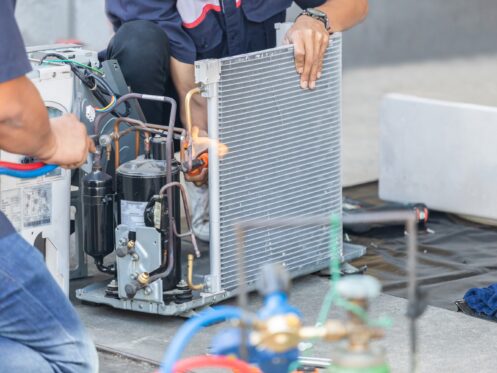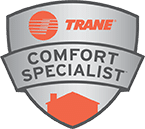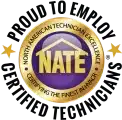This is an exciting time to be selecting a new HVAC system. The technologies are more advanced than ever, and numerous options are available. Let’s explore some of the top features you should consider for your home.
Cooling and Heating Output
Accurate sizing is integral to minimizing costs over the life of your system. The industry in the U.S. measures heating and cooling output in British thermal units (BTUs) and tonnage. One ton equals 12,000 BTUs. You’ll generally need 20-30 BTUs per square foot, but don’t use guidelines. Instead, have an HVAC installer perform a load calculation. It will account for your home’s floor plan, square footage, ceiling heights, building envelope, and more.
Heat Pumps
Many households throughout the U.S. are switching to heat pumps. Heat pumps are essentially two-way ACs that provide both cooling and heating. They’re just as efficient cooling as a central AC. Heat pumps are also more cost-effective heating than traditional options like furnaces and boilers. In warmer climates, a standard air-source heat pump is often good enough. There are ground-source and dual-fuel heat pumps for even greater heating efficiency.
Energy Efficiency Ratings
Energy-efficiency ratings are available for all HVAC equipment sold in the U.S. All equipment must meet federal standards, and high-efficiency systems cost more but can save money over time. An experienced installer will help you strike the right balance between added initial costs and long-term savings.
The seasonal energy efficiency ratio (SEER2) indicates the energy efficiency of cooling systems over a summer. The higher the SEER2 rating, the more efficient the cooling. The heating seasonal performance factor (HSPF2) is similar but indicates heat pump heating efficiency over a winter. The annual fuel utilization efficiency (AFUE) measures the heating performance of furnaces and boilers. As with SEER2 and HSPF2, the higher the AFUE, the higher the efficiency.
ENERGY STAR
Federal energy-efficiency standards for HVAC equipment are legal requirements for manufacturers. The Environmental Protection Agency sets standards for high-efficiency systems. While not a legal requirement, systems that meet these higher standards through independent lab testing receive ENERGY STAR certification. That label gives you confidence in the energy efficiency of your new system.
Energy Incentives
There are federal tax credits available for high-efficiency HVAC systems. You may be able to claim rebates too from federal, state, local, and private sources. Often, ENERGY STAR certification is the main criterion for whether you’re eligible.
Energy Efficiency Enhancements
There are many technological enhancements that set high-efficiency HVAC systems apart from their standard counterparts. Consumers should consider several in particular.
Variable-Speed Air Handler
Traditional HVAC systems run at a constant speed. Variable-speed air handlers reduce energy usage by ramping up and down as needed. A variable-speed blower is a strong investment because it can benefit both your cooling and heating systems.
Condensing Heating
If you opt for a fuel-burning heating system, choose a condensing furnace or boiler. Traditional fuel-burning heating systems lose heat through their exhausts, which is necessary to ventilate toxic gases. High-efficiency models have a condensing system to reclaim much of that heat. That can improve fuel usage by 10% or more.
Multi-Stage Heating
High-efficiency furnaces can have modulating burners as well. Often referred to as multi-stage furnaces, these systems can use less fuel based on the home’s current heating needs. There are condensing multi-stage furnaces on the market that achieve 98.5% efficiency.
Air Quality
Indoor air pollution is a growing health concern. While forced-air HVAC systems don’t cause indoor air quality issues, they can exacerbate them. The choices you make now can have a dramatic effect on improving your home’s air quality in the years ahead.
MERV
All HVAC systems will have at least one filter to help keep the equipment clean and minimize the air quality impact. The industry uses the minimum efficiency reporting value (MERV) to measure filter effectiveness. The top systems support up to a MERV 13 filter. At MERV 13, a filter will remove at least 90% of particles of 3.0 microns in size and larger. You shouldn’t use a higher MERV than your system supports because it will restrict air pressure too much.
Ventilation
Traditional HVAC systems recycle the air in the home. In other words, they provide circulation but not ventilation. You can improve ventilation by adding a mechanical ventilator. There are also advanced ventilator systems: heat recovery ventilators (HRVs) and energy recovery ventilators (ERVs). Both HRVs and ERVs can preheat and precool the incoming fresh air. That can improve efficiency and offset how soon into a season you need to run your main cooling or heating system. ERVs can also add and remove moisture from the air to help optimize relative humidity (RH).
Other Considerations
A whole-home dehumidifier can improve RH and efficiency during summer. A whole-home humidifier can help offset the drying-out effect that furnaces can cause. For sterilization, there are both coil and in-duct ultraviolet (UV) purifiers. For the removal of gases and chemicals and more advanced removal of particulates, consider adding an in-duct air purifier.
Noise Output
HVAC manufacturers provide noise output ratings for their systems in decibels (dB). Be mindful that a lower dB is more important for mini-splits, which operate directly in your living space. For central units, 50-60 dB is generally acceptable. The quietest models produce noise levels closer to the lower end of that range. Your installer can also dampen noise output with insulation for the blower and ducts.
Smart Features
Plan to purchase a new smart thermostat alongside your new heating and cooling system. Through scheduling alone, a smart thermostat can reduce annual cooling and heating costs by up to 10%. Smart thermostats provide remote access and control as well, and there are some other notable features to consider.
Predictive Maintenance
Predictive maintenance is generally an onboard feature. This system can monitor system performance and recognize when it’s outside standard operating parameters. It can then alert you to schedule maintenance. The industry estimates that this feature can lower energy costs by 30% and maintenance and repair costs by 40%.
Energy Monitoring
Smart thermostats with energy monitoring can track your energy usage daily, monthly, and annually. Through reports, this feature can help you minimize your usage. Many models can help you save through rate awareness and automatic adjustments as well. Your local utility company may offer a demand response program. If so, ensure that you choose a compatible thermostat.
HVAC Zoning
Zone control compartmentalizes your HVAC system. That provides comfort, air quality, and energy efficiency benefits because you can control zones independently. Variable-speed air handlers and smart thermostats are key components of such systems. Your home will also need duct dampers or smart vents.
Personalized HVAC Installation in Greater San Antonio
Air Authority, A Riteway Service Company is a proud ACCA and TACCA member with many years of experience in heating and cooling services. We employ NATE-certified technicians who install ducted and ducted cooling, heating, and air quality solutions.
We are a proud Trane Comfort Specialist but install all HVAC brands. Our company offers free estimates for installations, often has promotions available, and provides financing on approved credit. Call today or contact us online to schedule an in-home installation consultation.





